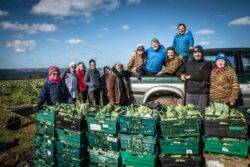With food poverty a growing issue, I think we need more support for gleaning groups (Picture: Gleaning Cornwall)
I stooped low to slice the stem of cauliflower, relishing the feel of damp, bare earth on my fingertips, before tossing it into the back of a waiting pick-up truck.
There were around 15 of us, spread out across the field, racing against the clock to pick as much veg as possible, stopping only for a short break and a chat over tea and cake.
Often we’ll have just a small window of opportunity to pick produce before a field is ploughed and replanted because farmers have to get it back into use as soon as possible.
This was a very different kind of harvest, though.
We were picking all this food by hand, without the help of huge, expensive machines. And we were doing it for free – with the farmer’s blessing – by reviving an ancient practice called gleaning.
Later, the cauliflowers would be piled into crates and distributed to thousands of needy people through food banks and soup kitchens – the freshest, most nutrient-packed produce you can imagine.
It just didn’t make sense to me that people were going hungry while food was left to rot (Picture: Annie Bungeroth)
Gleaning – gathering leftover fruit and veg after crops have been harvested – has been around for centuries. It even gets a mention in the Old Testament, and in 18th century England, the poor had a legal right to help themselves to unharvested crops.
Sadly that came to an end in 1788 when a landmark legal case ruled that no one had the right to glean on private land. As a result, landowners began restricting access to their fields.
Now, in the ongoing cost-of-living crisis and with modern, intensive farming practices contributing to mountains of food waste, gleaning is making a massive comeback.
I set up the Gleaning Cornwall Network in 2021 after watching a documentary exposing the hidden deprivation in my home county.
Holly founded the Gleaning Cornwall Network (Picture: Annie Bungeroth)
Through volunteer work, I was already involved in community farming and regenerative agriculture, which is about restoring soil health to help reverse the effects of climate change.
I knew that, thanks to the demanding nature of our major supermarkets, loads of fruit and veg was going to waste simply because it looked a bit wonky, or was the wrong size.
Farmers have to over-produce crops so they have enough of the right size and calibre to meet their supermarket contracts, and often they plant more than they’re likely to need to give them some wiggle room if they get a spell of bad weather.
Occasionally, the market is awash with produce or it doesn’t make financial sense to pay for more harvesting, and farmers instead have to plough it back into soil.
It all adds up to millions of tonnes of wasted produce, and it just didn’t make sense to me that people were going hungry while food was left to rot in the fields.
I’d had the idea of gleaning in my head for a while, but now it just seemed imperative (Picture: Gleaning Cornwall)
I felt so frustrated. I’d heard from a friend who runs a local food bank how one of her recipients had been diagnosed with malnutrition because she wasn’t getting enough fresh produce. It just appalled me.
Because of my voluntary work in agriculture and climate activism, I had access to a fabulous and dedicated bunch of willing environmental activists and hippies, and I was sure that between us we could help.
I’d had the idea of gleaning in my head for a while, but now it just seemed imperative. I thought I could rustle up maybe 50 volunteers.
So to begin with, I just put a shout-out on Facebook in 2021, and our group of volunteers – now about 350 strong – grew organically from there. We get between five and 20 turning up for each session and run them at least once or twice a week on farms and smallholdings all over Cornwall.
Some of the testimonials we get back from food bank users are heartbreaking (Picture: Gleaning Cornwall)
Our volunteers include teachers, engineers, families and a priest. Whatever the weather, you always come away feeling lifted up. We’re out in nature, chatting, doing something we know is going to make a difference. It’s a huge mental health boost, and many are learning how to better prepare and cook local seasonal produce
With grant funding, I’ve been able to employ a small team of part-time co-ordinators, but it’s a constant scramble trying to raise money. Totting up wages, fuel and the cost of vehicles, it’s totalling around £50,000 a year to run the group.
Between us, we organise gleans, liaise with food banks and community kitchens, and arrange the logistics and deliveries to get the produce to the people who most need it. But the first step, and often the hardest, is finding farms willing to let us pick leftover produce.
Sometimes we’ll just give them a call, or we might drive down to the farm track and speak to them in person. I’ve been ignored and I’ve been told bluntly, ‘no’.
We do try to persevere in trying to convince them though, just because it’s so important – some of the testimonials we get back from food bank users are heartbreaking. People are at breaking point.
Last year, our network gleaned about 80 tonnes of food in Cornwall alone (Picture: Gleaning Cornwall)
After a couple of years, we’ve got around 20 farms who we work with regularly. We build a rapport with them, and show them that we’re a serious operation. We’ve also got the appropriate insurance cover for our volunteers, as well as a first aider on site.
Besides the cauliflowers, we get potatoes, broccoli, squashes, kale, cabbage, parsnips, beetroot, apples and a few carrots. We are lucky that Cornwall grows so much field veg.
Then through over 60 food banks, community kitchens and community larders across Cornwall and west Devon, the food helps feed around 6,000 people in need each week.
It makes a huge difference. Food banks often get lots of cheap tinned and processed foods. They miss out on the fresh stuff, which is what families really need.
Our veg is super-fresh – it can go from field to fork within the space of a few hours. Families are so grateful – they’re getting food fresher than they could ever buy in the shops, and the soup kitchen chefs we work with can’t believe the quality.
Last year, our network gleaned about 80 tonnes of food in Cornwall alone, worth around £145,000. It’s a start, but that’s still a tiny fraction of the 9.5million tonnes we waste each year in the UK, valued at more than an eye-watering £19billion.
The vast majority of annual food waste – around 70% – comes from our homes, around 15% – amounting to 3.6million tonnes – at farms, and the rest is wasted in shops and during transportation and processing.
There are massive greenhouse gas emissions associated in producing and wasting all this precious food at a time when we desperately need to reduce our emissions.
More: Trending
And with food poverty a growing issue, I think we need more support for gleaning groups, where it’s suitable.
In the meantime, we can all do our bit to help. We can eat leftovers for breakfast, we can learn how to cook local, seasonal produce, and we can manage our fridges, freezers and fruit bowls better.
Right now, food prices are rocketing, making things harder for many and putting a squeeze on food banks. That said, we do need to appreciate the real value of food, and the care, and hard graft of the people who produce it.
To donate to the Gleaning Cornwall Network, visit their website here. To find out more about gleaning or to get advice on setting up your own group, visit Feedback Global’s ‘Gleaning Network’ page here.
As told to Robin Eveleigh
Do you have a story you’d like to share? Get in touch by emailing [email protected].
Share your views in the comments below.
MORE : Feeding the nation: ‘Why I’m hosting a giant food swap for the Coronation Big Lunch’
MORE : Labour MP accused of ‘glorifying gambling to donate to food bank’
MORE : More than 1,000,000 emergency food parcels given to children in the last year
Gleaning – gathering leftover fruit and veg after crops have been harvested – has been around for centuries and I’ve resurrected it in Cornwall.





